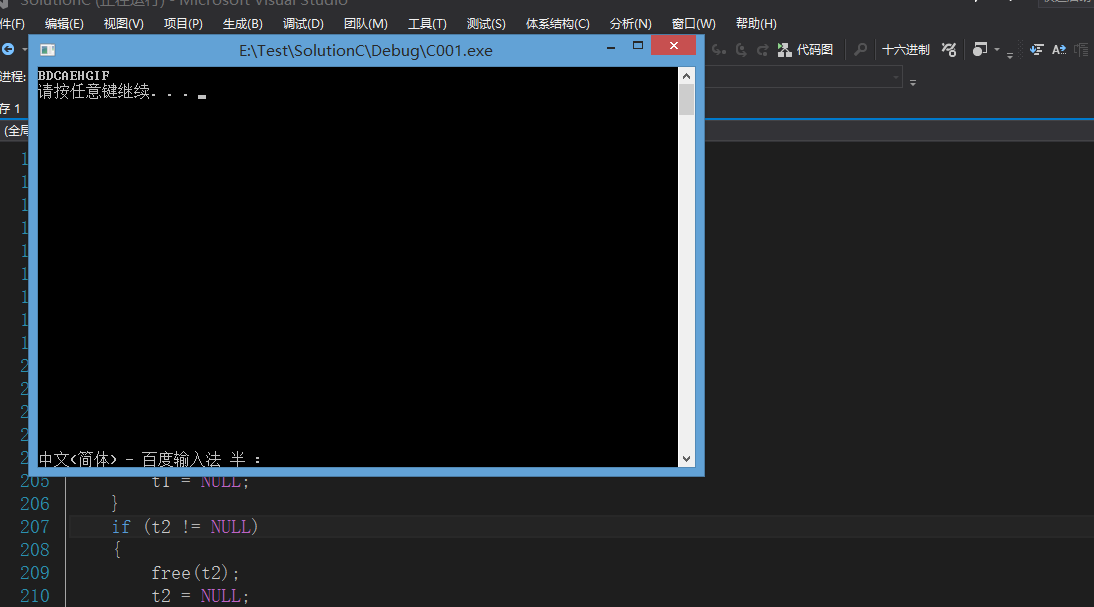
//树的遍历--非递归遍历 #include<stdio.h> #include<stdlib.h> #include<string.h> #include"LinkStack.h" /* 步骤1:结点的所有路径情况 如果结点有左子树,该结点入栈; 如果结点没有左子树,访问该结点; 分析3:路径所有情况 如果结点有右子树,重复步骤1; 如果结点没有右子树(结点访问完毕),回退,让栈顶元素出栈,访问栈顶元素,并访问右子树,重复步骤1 如果栈为空,表示遍历结束。 */ //定义二叉树结构体 typedef struct _TreeNode{ char data; struct _TreeNode * leftchild; struct _TreeNode * rightchild; }TreeNode, *TreeNodePointer; TreeNodePointer GoLeft(TreeNodePointer root, LinkStack * stack){ if (root == NULL || stack==NULL) { printf("参数不可以为空! "); return NULL; } while (root->leftchild){ //入栈 LinkStack_Push(stack, root); root = root->leftchild; } return root; } //树的非递归遍历 void TreeErgodic(TreeNodePointer root){ if (root==NULL) { return; } //1.创建栈 LinkStack * stack = LinkStack_Create(); if (stack == NULL) { printf("创建栈失败 "); return; } /* 如果结点有左子树,该结点入栈; 如果结点没有左子树,访问该结点; */ TreeNodePointer t = GoLeft(root, stack); /* 此时t不可能为NULL,因为root不为NULL */ printf("%c", t->data); while (t){ //如果结点有右子树,重复步骤1; if (t->rightchild!=NULL) { t = GoLeft(t->rightchild, stack); printf("%c", t->data); } //如果结点没有右子树(结点访问完毕),回退,让栈顶元素出栈,访问栈顶元素,并访问右子树,重复步骤1 else if (LinkStack_Size(stack)>0){ t = (TreeNodePointer)LinkStack_Pop(stack); printf("%c", t->data); } //如果栈为空,表示遍历结束。 else{ t = NULL; } } //销毁栈 LinkStack_Destroy(&stack); } void Test(){ //定义结构体对象 TreeNodePointer t1 = NULL, t2 = NULL, t3 = NULL, t4 = NULL, t5 = NULL,t6=NULL,t7=NULL,t8=NULL,t9=NULL; t1 = (TreeNodePointer)malloc(sizeof(TreeNode)); if (t1 == NULL) { printf("分配内存失败!"); goto END; } //初始化数据 memset(t1, 0, sizeof(TreeNode)); t2 = (TreeNodePointer)malloc(sizeof(TreeNode)); if (t2 == NULL) { printf("分配内存失败!"); goto END; } //初始化数据 memset(t2, 0, sizeof(TreeNode)); t3 = (TreeNodePointer)malloc(sizeof(TreeNode)); if (t3 == NULL) { printf("分配内存失败!"); goto END; } //初始化数据 memset(t3, 0, sizeof(TreeNode)); t4 = (TreeNodePointer)malloc(sizeof(TreeNode)); if (t4 == NULL) { printf("分配内存失败!"); goto END; } //初始化数据 memset(t4, 0, sizeof(TreeNode)); t5 = (TreeNodePointer)malloc(sizeof(TreeNode)); if (t5 == NULL) { printf("分配内存失败!"); goto END; } //初始化数据 memset(t5, 0, sizeof(TreeNode)); t6 = (TreeNodePointer)malloc(sizeof(TreeNode)); if (t6 == NULL) { printf("分配内存失败!"); goto END; } //初始化数据 memset(t6, 0, sizeof(TreeNode)); t7 = (TreeNodePointer)malloc(sizeof(TreeNode)); if (t7 == NULL) { printf("分配内存失败!"); goto END; } //初始化数据 memset(t7, 0, sizeof(TreeNode)); t8 = (TreeNodePointer)malloc(sizeof(TreeNode)); if (t8 == NULL) { printf("分配内存失败!"); goto END; } //初始化数据 memset(t8, 0, sizeof(TreeNode)); t9 = (TreeNodePointer)malloc(sizeof(TreeNode)); if (t9 == NULL) { printf("分配内存失败!"); goto END; } //初始化数据 memset(t9, 0, sizeof(TreeNode)); //填充数据域 t1->data = 'A'; t2->data = 'B'; t3->data = 'C'; t4->data = 'D'; t5->data = 'E'; t6->data = 'F'; t7->data = 'G'; t8->data = 'H'; t9->data = 'I'; //建立树之间的关系 t1->leftchild = t2; t1->rightchild = t5; t2->leftchild = NULL; t2->rightchild = t3; t3->leftchild = t4; t3->rightchild = NULL; // t5是t4的左孩子 t4->leftchild = NULL; t4->rightchild = NULL; //t5没有孩子节点 t5->leftchild = NULL; t5->rightchild = t6; t6->leftchild = t7; t6->rightchild = NULL; t7->leftchild = t8; t7->rightchild = t9; t8->leftchild = NULL; t8->rightchild = NULL; t9->leftchild = NULL; t9->rightchild = NULL; //非递归遍历 TreeErgodic(t1); printf(" "); END: if (t1 != NULL) { free(t1); t1 = NULL; } if (t2 != NULL) { free(t2); t2 = NULL; } if (t3 != NULL) { free(t3); t3 = NULL; } if (t4 != NULL) { free(t4); t4 = NULL; } if (t5 != NULL) { free(t5); t5 = NULL; } } void main(){ Test(); system("pause"); }
